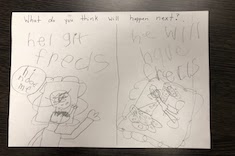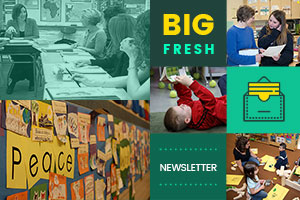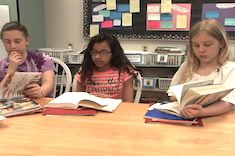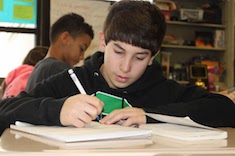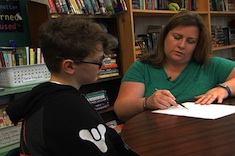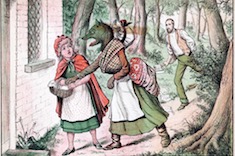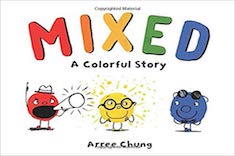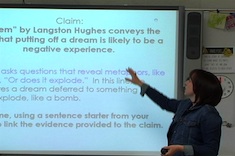Library
Choice Literacy Articles & Videos
The Choice Literacy library contains over 3,000 articles and 900 videos from 150+ contributors. Classic Classroom and Literacy Leadership subscribers have access to the entire library. Content is updated continuously, with five to six new features published each week.
Latest Content
Don’t Forget to Marvel
Ruth Ayres is interrupted during a busy day by a first-grade teacher who enthuses over the details in a student draft. This leads to some reflection on the importance of taking time to marvel.
A Minilesson on Minilessons
Franki Sibberson leads a minilesson in her fifth-grade classroom to help students design their own lessons. Students also assess what goes into a high-quality minilesson.
Think Small
Christy Rush-Levine realized she had to help her students find a different “why” for their time in her classroom and school beyond test scores and standards dictates.
Secret Reader
Suzy Kaback marvels at a very young learner who is a “secret reader,” and this leads her to reassess the value of constantly celebrating new skills in school communities.
March 29, 2019 Salad Dressing and Soft Spots
We look at literacy homework in this week’s newsletter.
Poetry Path
Gretchen Schroeder outlines a way to involve the entire school community in engaging in poetry.
Google It!
Ruth Ayres encourages her son to use the web for assistance when doing homework, and then has to ponder whether what she is advocating qualifies as cheating.
Stretching Writing in First Grade with Details
Bitsy Parks makes the home-school connection with first grader Grace early in the year as she writes about her birthday party.
Unadulterated Reading
Just reading. Pure, unadulterated reading. That’s the reading homework that matters most in the long run. Stephanie Affinito explains why.
Small Group: Creativity
Franki Sibberson pulls together a group of fifth graders to explore writing mentors together.
March 22, 2019 Spring Break
We’re celebrating spring with our Annual Spring Break edition of the newsletter, featuring the 10 most popular articles published over the past year.
March 15, 2019 Impossible Negotiations
Argument and persuasion is the focus of this week’s newsletter.
Conferences with Parents of English Language Learners
Jen Schwanke and Stella Villalba share practical tips for conferring with parents of English language learners.
March 8, 2019 With Students in Mind
We consider student identity and ownership in this week’s newsletter.
Opinion Proof Lesson
Christy Rush-Levine helps her students create an “opinion proof chart” in their notebooks. This exercise helps them build their skills in backing up opinions with evidence.
A Fresh Take on Persuasive Writing
Louise Wrobleski uses video clips, children’s literature, and newspaper articles to teach middle school students new ways to craft persuasive writing.
Reading That Changes Us
Tara Barnett and Kate Mills slow down the “Article of the Week” nonfiction reading activity, making space for more reflection and thoughtful discussion.
March 1, 2019 Joy and Ambition
This week we dive in to understanding scaffolds.
February 22, 2019 What’s Your Catchphrase?
This week we consider the ways mentor texts can be thoughtful “detours” for learning.
Student-Led Minilesson: Annotating Reading with Sticky Notes
Students can claim who they are as readers and writers by designing and presenting minilessons to their peers. In this week’s video, fifth grader Reagan from Franki Sibberson’s classroom presents a lesson on annotating reading with sticky notes.
Building Cultural Awareness
Stella Villalba explains how frustrations with the families of English language learners can come from misunderstandings of cultural norms, and gives some tips for building awareness.
Reading Bingo
Gretchen Schroeder has developed a fun version of Reading Bingo to help students explore their identity as readers. The activity includes clever social media inspired options like creating memes and “bookstagram” posts.
The Power of Paper
Melanie Meehan details how different paper options can be a powerful scaffold for students as they explore different writing genres. She includes many sample scaffolds to download for use in an opinion writing unit.
Scaffolding Revision with a Mentor Text
Tara Barnett and Kate Mills show how to break down mentor texts into brief excerpts for step-by-step scaffolding of writers in the intermediate grades.
Crafting the Basics: First-Grade Writing Conference
Bitsy Parks confers with Aubrey early in the year, using books from whole-class lessons as a scaffold for understanding key text elements like title, author, and illustrations.
Exploring Dystopian Literature: Fifth-Grade Reading Conference
Katherine Sokolowski confers with Ian about The Giver, broadening his understanding of the text to consider other dystopian literature.
Bringing Multiple Texts and Perspectives into Teaching Point of View
Katherine Sokolowski finds her students are struggling to understand point of view. She takes a detour over a week with mentor texts, quick assists from favorite writers on Twitter, and practice sessions retelling Little Red Riding Hood to teach the concept.
Detour Texts
Clare Landrigan and Tammy Mulligan explain the concept of “detour texts”—picture books to use as mentor texts in the intermediate grades to illustrate complex literary elements. They also share three of their favorite new children’s books to use as detours.
February 15, 2019 Abandoned Canoes
This week we focus on revision minilessons in the intermediate grades.
Revising Literary Analysis Essays: Supporting Claims
Christy Rush-Levine presents a minilesson to her eighth-grade students about revising their literary analysis essays, using an analogy about putting furniture together.
Browse Content By
Type
Category
- Assessment Tools
- Big Fresh Archives
- Booklists
- Choice Numeracy
- Classroom Design
- Common Core
- Community Building
- Conferring
- Content Literacy
- Digital Literacy
- English Language Learners
- Equity
- Family Relations
- Free Samples
- Guiding Groups
- Leadership
- Literacy Coaches
- Mentor Texts
- Minilessons
- New Teacher Mentors
- Podcasts
- Poetry
- Quote Collections
- Reading Strategies
- Self Care
- Struggling and Striving Learners
- Talking and Listening
- Teacher Study Groups
- Teaching Reading
- Teaching Writing
- Word Study and Vocabulary
Author
- Melissa Quimby
- Nawal Qarooni
- Gwen Blumberg
- Julie Cox
- The Lead Learners
- Hannah Tills
- Josie Stewart
- Ruth Metcalfe
- Mallory Messenger
- Becca Burk
- Jodie Bailey
- Vivian Chen
- Mary Brower
- Tiffany Abbott Fuller
- Stephanie Affinito
- Ruth Ayres
- Leigh Anne Eck
- Heather Fisher
- Shari Frost
- Julie Johnson
- Suzy Kaback
- Gigi McAllister
- Shirl McPhillips
- Melanie Meehan
- Cathy Mere
- Debbie Miller
- Tara Barnett and Kate Mills
- Tammy Mulligan
- Dana Murphy
- Bitsy Parks
- David Pittman
- Brenda Power
- Heather Rader
- Matt Renwick
- Mandy Robek
- Christy Rush-Levine
- Gretchen Schroeder
- Jen Schwanke
- Brian Sepe
- Katherine Sokolowski
- Stella Villalba
- Jennifer Vincent
Grade Level
Choice Literacy Membership
Articles
Get full access to all Choice Literacy article content
Videos
Get full access to all Choice Literacy video content
Courses
Access Choice Literacy course curriculum and training

